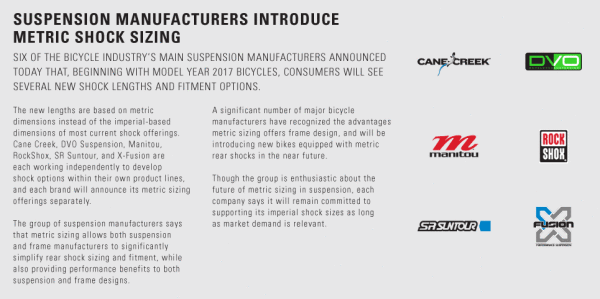Just when you thought we were through with standards changes for a while, the industry has come together to introduce new metric sizing standards for rear shocks. The collaboration will affect frame manufacturers, as upcoming frames will need to be designed to work with specific eye-to-eye measurements and stroke lengths.
From initial conversations we’ve had with Rockshox, one of the big benefits to shock manufacturers is more standardization of offerings, which means they can better design, tune and manufacturer shocks around specific parameters rather than needing to create something new for each bike brand.
Cane Creek, DVO, Manitou, Rockshox, SR Suntour and X-Fusion are all on board. Bounce on down for some industry comments…

“Some manufacturers expect to see durability improvements. For us, it increases the available space for the IFP’s gas volume and damping piston designs,” says Manitou’s chief suspension engineer, Ed Kwaterski. “Others could have increased overlap between the shaft and air can’s bushings and rings – the further apart they are, the more laterally stiff the shock can be. While it the shock shouldn’t be carrying side loads, it could help in some cases. So, some of the sizing being discussed involves lengthening the eye-to-eye for a given stroke length. And it’ll reduce SKUs for all of the suspension brands because, for us anyway, we’re currently stocking more than 100 SKUs, which is ridiculous. This change will standardize the sizes offered and reduce the number of items required to be stocked.”
“It definitely allows for the designers to do more stuff with the shocks internally,” adds John Pelino, DVO’s general manager. “For a size like a 200×57, there’s zero room left over when that shock is at full compression, so you’re very limited as to what you can do with the damping. So switching to something like a 230×60 or 210×55 gives the engineers more room to develop the damping in the shock. The kinematics of the bike are where it’s really going to affect things the most, but it’s going to have to get bigger to work with the new crop of shocks under these updated standards.
“Trunion shocks will likely get more popular, which are shock canisters that put the air can’s mounting bolts on the side of the shock rather than adding length for an eyelet.”
Unfortunately, this does mean more shock sizes and SKUs for dealers or distributors to stock (or at least be aware of). But, the result should be better suspension.
